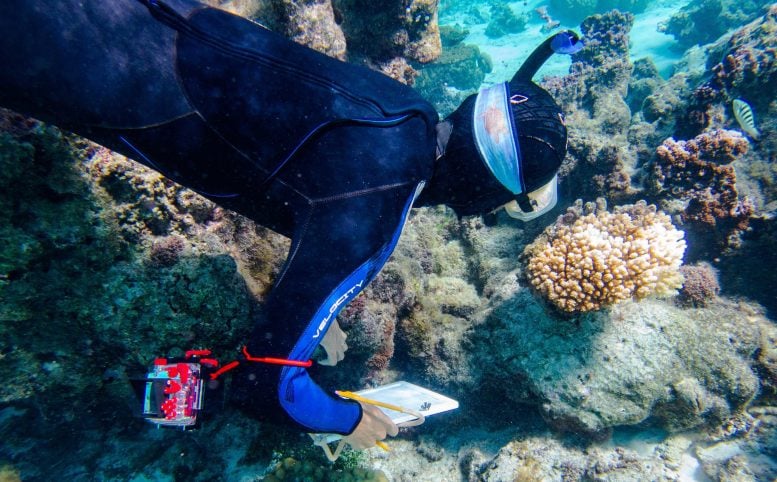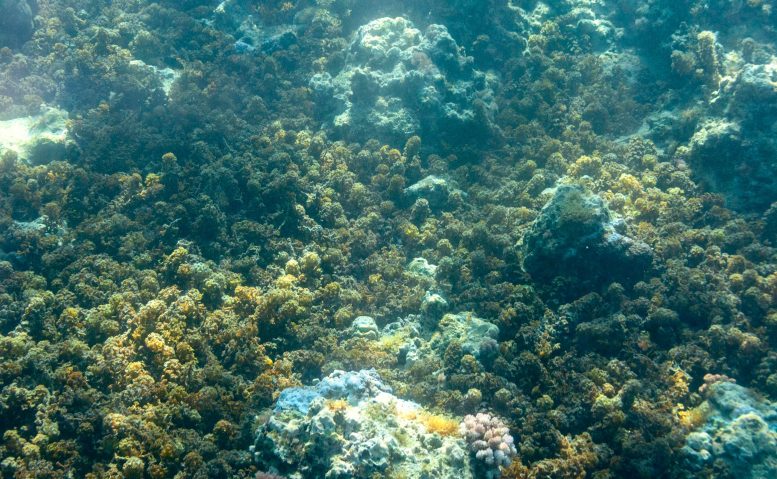
New findings from research conducted in Moorea reveal that the existence of coral skeletons has a significant impact on the recovery of reefs following bleaching events.
Natural disasters can wreak havoc in a region, leading to the abrupt destruction of species that make up an ecosystem. The manner in which this occurs can significantly impact the recovery process. For instance, fires reduce the landscape to ashes, while heatwaves create a legion of wooden remnants. Similarly, storm surges and coral bleaching wreak havoc under the sea.
Researchers from UC Santa Barbara delved into how these two types of disturbances could impact coral reefs. They discovered that coral finds it more challenging to recover from bleaching than from storms, even when the mortality rate was comparable in both situations. The skeletal remains from bleaching provide a shield for algae, which outcompete the slow-growing coral. This research, led by doctoral candidate Kai Kopecky, was recently published in the journal Ecology.
Most shallow-water corals host symbiotic algae that provide the animals with food in exchange for a safe home and nutrients. But extreme conditions can throw this arrangement out of alignment, causing the coral to expel their partners in a process known as bleaching, which is often fatal.

Researchers at UC Santa Barbara have studied coral and their reef ecosystems around the island of Moorea, French Polynesia since the late 1980s. Kopecky’s second visit to the island coincided with a major bleaching event. “To see lots of bright white coral skeletons is very jarring,” he said, but he took solace that the island’s reefs have proven remarkably resilient in the past.
Unfortunately, a different pattern began to emerge this time. Seaweed, a major competitor with coral for space on the reef, began colonizing the bleached skeletons. Kopecky wondered if the skeletons’ presence was setting the reef on a pathway toward a more algae-dominated state.
Previous work at Moorea showed that tropical reefs can host either coral- or seaweed-dominated communities. These distinct states are resilient to small disturbances, but a large shock can flip the ecosystem from one to the other in a process called hysteresis. Once this happens, the reef won’t revert to its previous state even if the conditions do. The system has found a new equilibrium.
Kopecky developed a mathematical model to compare reef dynamics after a bleaching event — which leaves skeletons in place — and after a storm — which scours the reef bare. He used a system of five differential equations to capture the transition between empty space, live and dead branching coral, and seaweed cover on the reef.
The results were telling. “Just the fact that those skeletons are left on the reef results in these fundamentally different patterns of recovery,” Kopecky said.
Coral skeletons seem to protect young algae from herbivores that would otherwise keep it in check. The animals can’t get in all the crevices, so the algae gains a foothold from which to spread.
This protection doesn’t appear to provide the same benefits to young coral. The authors suspect that coral don’t face as much pressure from predators as algae do. What’s more, algae can quickly outgrow coral when given the chance. “Coral is literally laying down rock, while the algae are mostly just fast-growing, soft, leafy material,” said senior author Holly Moeller, an assistant professor of ecology, evolution and marine biology.
Reef buildup is a slow process, with coral death usually balanced by recruitment. New growth incorporates dead skeletons into the larger reef structure. But bleaching kills a lot of coral all at once — especially the oldest and youngest — and the skeletons eventually become brittle through erosion. It’s not a strong foundation for young coral to build their lives upon.
If dead skeletons hinder coral recovery, why not simply remove them?
This approach is gaining support in other ecosystems. “Think of prescribed fires or the thinning of dead trees in forests so that the system is more resilient to future disturbances,” Kopecky said.
However, coral skeletons provide many benefits. They form a habitat for sundry kinds of animals and some evidence suggests that the structural complexity of a reef correlates with faster coral recovery.
“The effect really depends on what the nature of that structure is,” Kopecky said. Material density, strength, and spatial layout all influence reef dynamics. “Those aspects need to be taken into consideration before you go out and just start jackhammering the reef.”
The team has a suite of ongoing experiments in Moorea, including one exploring how the reef recovers when dead coral skeletons are removed. Several others are testing the assumptions Kopecky used to create his model. For example, how much does dead coral actually reduce herbivory? And how do the skeletons affect the growth of living corals?
“Kai’s study is a classic example of the value of mathematical models in ecology,” Moeller said. Coral can live for hundreds of years, and reef recovery can take decades. “That’s just not an experiment that you can do realistically.
“But if you have a model,” she continued, “and you trust the way you set that model up because you’ve done other experiments, then you can make these projections decades into the future.”
Reference: “Material legacies can degrade resilience: Structure-retaining disturbances promote regime shifts on coral reefs” by Kai L. Kopecky, Adrian C. Stier, Russell J. Schmitt, Sally J. Holbrook and Holly V. Moeller, 18 February 2023, Ecology.
DOI: 10.1002/ecy.4006
The study was funded by the National Science Foundation and the Simons Foundation.